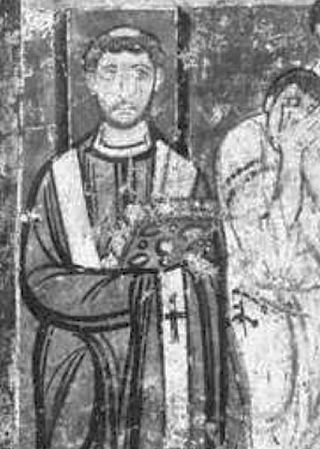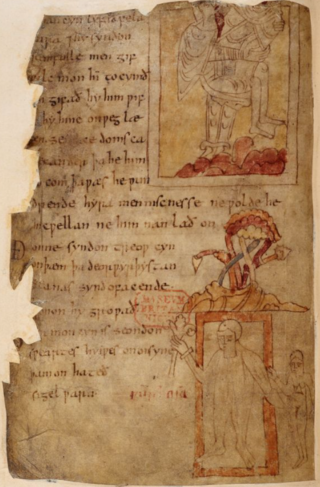
The House of Orsini is an Italian noble family that was one of the most influential princely families in medieval Italy and Renaissance Rome. Members of the Orsini family include five popes: Stephen II (752–757), Paul I (757–767), Celestine III (1191–1198), Nicholas III (1277–1280), and Benedict XIII (1724–1730). In addition, the family included 34 cardinals, numerous condottieri, and other significant political and religious figures.

Pope Leo IV was the bishop of Rome and ruler of the Papal States from 10 April 847 to his death. He is remembered for repairing Roman churches that had been damaged during the Arab raid against Rome, and for building the Leonine Wall around Vatican Hill to protect the city. Pope Leo organized a league of Italian cities who fought and won the sea Battle of Ostia against the Saracens.

Michael II, called the Amorian and the Stammerer, reigned as Byzantine Emperor from 25 December 820 to his death on 2 October 829, the first ruler of the Amorian dynasty.

Johannes Leo Africanus was an Andalusi diplomat and author who is best known for his 1526 book Cosmographia et geographia de Affrica, later published by Giovanni Battista Ramusio as Descrittione dell'Africa in 1550, centered on the geography of the Maghreb and Nile Valley. The book was regarded among his scholarly peers in Europe as the most authoritative treatise on the subject until the modern exploration of Africa. For this work, Leo became a household name among European geographers. He converted from Islam to Christianity and changed his name to Johannes Leo de Medicis. After he returned to North Africa in 1528, Leo reverted back to Islam.
This is an alphabetical index of people, places, things, and concepts related to or originating from the Byzantine Empire. Feel free to add more, and create missing pages. You can track changes to the articles included in this list from here.

Saeculum obscurum, also known as the Pornocracy or the Rule of the Harlots, was a period in the history of the papacy during the first two thirds of the 10th century, following the chaos after the death of Pope Formosus in 896 which saw seven or eight papal elections in as many years. It began with the installation of Pope Sergius III in 904 and lasted for 60 years until the death of Pope John XII in 964. During this period, the popes were influenced strongly by a powerful and allegedly corrupt aristocratic family, the Theophylacti, and their relatives and allies. The era is seen as one of the lowest points of the history of the papal office.
Ivan Stefan ruled as emperor (tsar) of Bulgaria for eight months from 1330 to 1331.

The Macedonian dynasty ruled the Byzantine Empire from 867 to 1056, following the Amorian dynasty. During this period, the Byzantine state reached its greatest extent since the Early Muslim conquests, and the Macedonian Renaissance in letters and arts began. The dynasty was named after its founder, Basil I the Macedonian who came from the theme of Macedonia.

The Alexander Romance is an account of the life and exploits of Alexander the Great. The Romance describes Alexander the Great from his birth, to his succession of the throne of Macedon, his conquests including that of the Persian Empire, and finally his death. Although constructed around an historical core, the romance is mostly fantastical, including many miraculous tales and encounters with mythical creatures such as sirens or centaurs.

Theoktistos or Theoctistus was a leading Byzantine official during the second quarter of the 9th century and the de facto head of the regency for the underage emperor Michael III from 842 until his dismissal and murder in 855. A eunuch courtier, he assisted in the ascent of Michael II to the throne in 820, and was rewarded with the titles of patrikios and later magistros. He held the high posts of chartoularios tou kanikleiou and logothetēs tou dromou under Michael and his son Theophilos. After Theophilos' death in 842, Theoktistos became a member of the regency council, but soon managed to sideline the other members and establish himself as the virtual ruler of the Empire. Noted for his administrative and political competence, Theoktistos played a major role in ending the Byzantine Iconoclasm, and fostered the ongoing renaissance in education within the Empire. He also continued the persecution of the Paulician sect, but had mixed success in the wars against the Arabs. When Michael III came of age in 855, his uncle Bardas persuaded him to throw off the tutelage of Theoktistos and his mother, the Empress-dowager Theodora, and on 20 November 855, Theoktistos was assassinated by Bardas and his followers.
John III was the longest-reigning Duke of Naples (928–968). He was the son and successor of Marinus I.

The Norman conquest of southern Italy lasted from 999 to 1194, involving many battles and independent conquerors.

Theodora Doukaina Komnene Palaiologina, also known as Theodora Vatatzaina, was the empress consort of the Byzantine emperor Michael VIII Palaiologos.
Leo (c.965–1026) was a German prelate who served as the Bishop of Vercelli from 999. Born in Hildesheim, he was made an archdeacon by 998 and was appointed to the see of Vercelli as the candidate of the Emperor Otto III and Pope Sylvester II following the assassination of Bishop Peter. He worked tirelessly for the extension of imperial authority in Italy during the reigns of Otto III, Henry II and Conrad II. He worked for the imperial chancery, receiving the high rank and title of logothete.

The Roman d'Alexandre en prose is one of many medieval "Alexander romances" relating the adventures of Alexander the Great, which were by then greatly elaborated with fantastical additions to the historical accounts. Alexander was one of the medieval "Nine Worthies," and his journeys eastward—and most especially the strange and exotic people and animals he encountered there—were treated in a number of different texts in a variety of genres. Based on the relatively large number of surviving manuscripts, as well as the deluxe quality of many of these productions, the Old French Roman d'Alexandre en prose can be considered the most popular and successful vernacular prose treatment of the legend.
This is a timeline of the presence of Eastern Orthodoxy in Greece from 717 to 1204. The history of Greece traditionally encompasses the study of the Greek people, the areas they ruled historically, as well as the territory now composing the modern state of Greece.
Theodora Megale Komnene, also known as Despina Khatun, was the daughter of John IV of Trebizond and Bagrationi who married the Aq Qoyunlu ruler Uzun Hasan in 1458. She became the mother of Halima Alamshah Hatun who became the mother of first Safavid king, Shah Ismail I.
Leo Tuscus was an Italian writer and translator who served as a Latin–Greek interpreter in the imperial chancery of the Byzantine Empire under Emperor Manuel Komnenos.

The Epistola Alexandri ad Aristotelem is a purported letter from Alexander the Great to the philosopher Aristotle concerning his adventures in India. Although accepted for centuries as genuine, it is today regarded as apocryphal. It is the primary source for most of the tales of the marvellous and fabulous found in later Alexander traditions.
The Navitas et victoria Alexandri Magni regis is a lost tenth-century Latin translation of the Greek Alexander Romance of Pseudo-Callisthenes, produced from a copy of a Greek manuscript discovered in Constantinople by Leo the Archpriest. Leo had undertaken a mission commissioned to him by John III of Naples. According to Domenico Comparetti, John III was a duke with an interest in the collection of letters and writings from wherever they could be found, of both secular and religious content. It is in this context that Leo was one of John's chief agents in the collection of Greek manuscripts followed by their translation into the Latin vernacular.